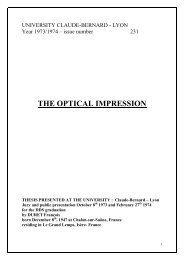english version(pg40to78) - Pr. François Duret
english version(pg40to78) - Pr. François Duret
english version(pg40to78) - Pr. François Duret
You also want an ePaper? Increase the reach of your titles
YUMPU automatically turns print PDFs into web optimized ePapers that Google loves.
F <strong>Duret</strong> and Coll. <strong>Pr</strong>incipes de fonctionnement et applications techniques de l’empreinte optique dans l’exercice de cabinet<br />
(traduction Anglaise)<br />
Page 77<br />
Yet if we study the bibliography about tri dimensional capture of<br />
complex objects, such as teeth, studies, we notice that few studied are<br />
finished and few articles have been written on this type of analysis.<br />
Why such difficulties and lack of information? We have the right to<br />
ask this question in 1985.<br />
By studying the fundamental principle of the tri dimensional capture<br />
of a tooth we can answer partly this interrogation.<br />
The most recent opto-electronic method and also the most famous is<br />
undoubtedly holography, discovered by Denis GABOR (Physics<br />
Nobel <strong>Pr</strong>ice in 1948) 3 . It is based on the interference of waves hitting<br />
an object and a reference wave. If this method is quite remarkable in<br />
its principle and the application offered by the laser 4 , it still stays<br />
rather complex and too expensive for a dental application both at the<br />
capture level (the object must stay still several minutes) and the<br />
restitution level (no reference system exist for the tooth). Despite<br />
these problems, a certain number of studies have appeared and<br />
particularly in the USA (PRYPUTNIEWICZ 5 and YOUNG 6 ), in<br />
Scandinavia and in France (DURET) (Fig. 5 and 6).<br />
The oldest method is stereovision 7 or photogrametry since it dates<br />
back to the end of the XVII th century. Two cameras look at the object<br />
under<br />
[Fig. 5: holographic setting by YOUNG (1977)]<br />
Les Cahiers de <strong>Pr</strong>othèse (50) pp 73 – 110, 1985



